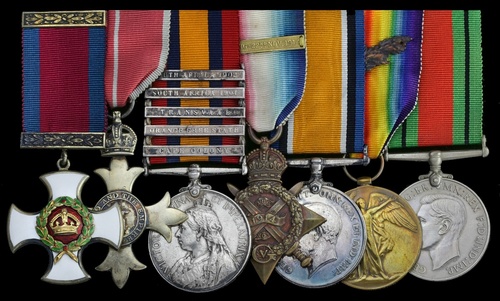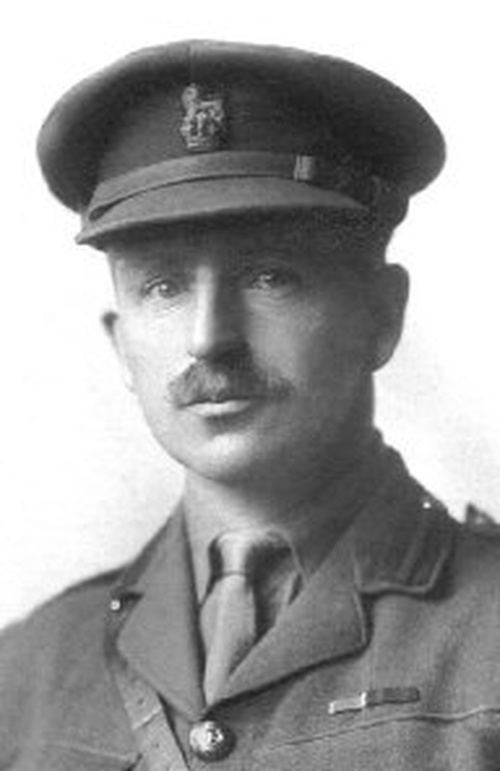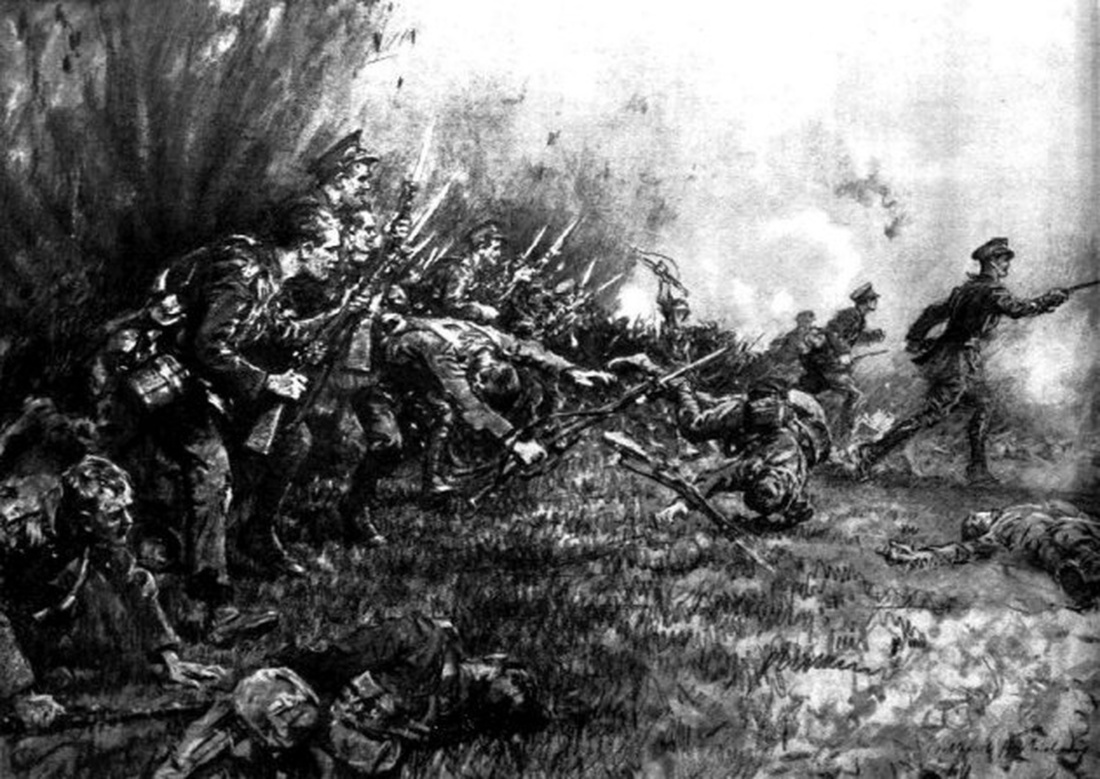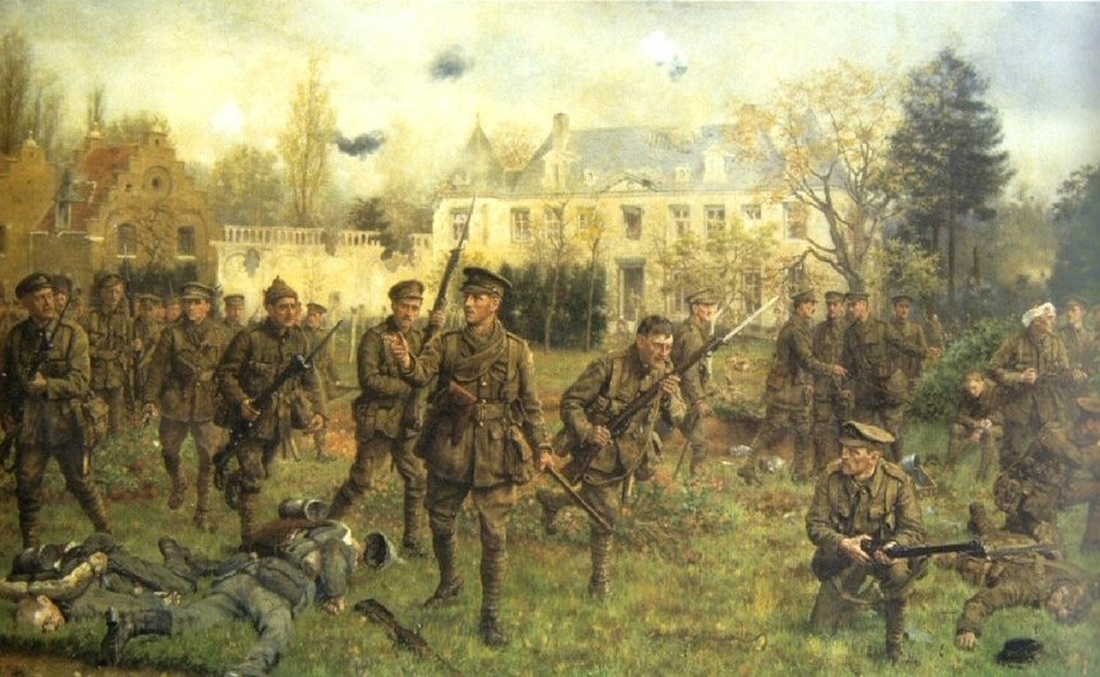Auction: 18001 - Orders, Decorations and Medals
Lot: 563
Sold by Order of a Direct Descendant
'Gheluvelt might seem a strange name for a park on Worcester's Barbourne Road in this most English of cities. The park, however, commemorates a remarkable feat of arms in October 1914 at Gheluvelt in Belgium by the Worcestershire Regiment, which in the words of Field Marshal Sir John French "saved the British Empire." '
A feature in WR Magazine, 10 March 2018, refers.
The important Great War battle of Gheluvelt 1914 operations D.S.O. group of seven awarded to Lieutenant-Colonel E. L. Bowring, Worcestershire Regiment
Distinguished Service Order, G.V.R., silver-gilt and enamel; The Most Excellent Order of the British Empire (O.B.E.), Military Division, Officer's 1st type breast badge, silver-gilt, hallmarks for London 1919; Queen's South Africa 1899-1902, 5 clasps, Cape Colony, Orange Free State, Transvaal, South Africa 1901, South Africa 1902 (Lieut. E. L. Bowring, Worc. Rgt.); 1914 Star, with clasp (Capt. E. L. Bowring, Worc. R.); British War and Victory Medals, M.I.D. oak leaf (Major E. L. Bowring); Defence Medal 1939-45, mounted as worn, edge bruising, contact marks, generally very fine (7)
D.S.O. London Gazette 18 February 1915:
'For services in connection with operations in the Field.'
Edward Langley Bowring was born on 11 September 1882, the son of Sir Charles Clement Bowring and Lady Violet Camilla Bowring of Park Grange, Derby.
Commissioned 2nd Lieutenant in the 3rd (Militia) Battalion, The Sherwood Foresters in January 1900, he transferred to the Regular Army with an appointment in the Worcestershire Regiment a year later. He subsequently witnessed active service in South Africa in the 1st Battalion, being present in operations in Cape Colony, Orange Free State and Transvaal in the period August 1901-May 1902 and advanced to Lieutenant (Queen's Medal & 5 clasps).
On being advanced to Captain in October 1908, he transferred to the 2nd Battalion in India, but the unit returned to the U.K. in March 1913, where it became part of 5th Brigade, 2nd Division.
It was in this capacity - as a Captain in 'C' Company - that Bowring went to France in August 1914. He quickly saw action at Frameries on the 22nd, when the battalion came under heavy artillery bombardment and took its first casualties; the civilian population stampeded through the streets in a 'terror-stricken mob'.
In September, Bowring and his comrades went into action alongside the 4th Guards Brigade, crossing the Marne and mounting an attack over ground strewn with dead and wounded on the Tilleul Spur; the Battalion held its positions on the spur for the remainder of the month but suffered serious casualties.
Gheluvelt 1914 - D.S.O.
But it was for his gallant part in the famous counter-attack at Gheluvelt in Belgium on 31 October 1914 that Bowring won his D.S.O. Of this historic action, the regimental museum website states:
'Daybreak of October 31st was calm and clear. The 2nd Worcestershire, in their reserve position west of the Polygon Wood, were roused early by the crash of gun-fire. The troops turned out, breakfasts were cooked and eaten, weapons were cleaned and inspected. Then for several hours the companies lay idle about their billets, listening to the ever-increasing bombardment and watching the German shrapnel bursting in black puffs of smoke above the tree-tops.
The 2nd Worcestershire were almost the last available reserve of the British defence. Nearly every other unit had been drawn into the battle-line or had been broken beyond recovery; and to an onlooker that last reserve would not have seemed very formidable. The Battalion could muster not more than five hundred men. Ten days of battle had left all ranks haggard, unshaven and unwashed: their uniforms had been soaked in the mud of the Langemarck trenches and torn by the brambles of Polygon Wood: many had lost their puttees or their caps. But their weapons were clean and in good order, they had plenty of ammunition, and three months of war had given them confidence in their fighting power. The short period in reserve had allowed them sleep and food. That crowd of ragged soldiers was still a fighting battalion, officers and men bound together by that proud and willing discipline which is the soul of the Regiment.
Hour by hour the thunder of the guns grew more intense. Stragglers and wounded from beyond the wood brought news that a great German attack was in progress. The enemy's infantry were coming on in overwhelming numbers against the remnants of the five British battalions, together mustering barely a thousand men, which were holding the trenches about the Menin Road.
Before midday weight of numbers had told. The Queen's and the Royal Scots Fusiliers had fought to the last, the Welch and the K.R.R.C. had been overwhelmed, the right flank of the South Wales Borderers had been rolled back. Gheluvelt had been lost, and a great gap had been broken in the British line. Unless that gap could be closed the British army was doomed to disaster.
So serious was the situation caused by the loss of Gheluvelt that orders were issued for the British artillery to move back, in preparation for a general retreat. At the same time it was decided that a counter-attack against the lost position should be made by the 2nd Worcestershire. Brigadier-General C. FitzClarence, V.C., was in command of the front about the Menin Road and soon after midday he sent for an officer of the 2nd Worcestershire to take orders. Major Hankey sent his Adjutant, Captain B. C. Senhouse Clarke.
Twenty minutes later Captain Senhouse Clarke returned, bringing word that the Battalion would probably be wanted for a counter-attack, and that meanwhile one company was to be detached to prevent the enemy from advancing up the Menin Road. 'A' Company was detailed for the latter duty. Led by Captain P. S. G. Wainman, the company advanced at 12.45 p.m. (the other officers of 'A' Coy. were Lieut. E. C. R. Hudson and 2/Lieut. G. A. Sheppard) to a position on the embankment of the light railway northwest of Gheluvelt. The company held the embankment during the following two hours, firing rapidly at such of the enemy as attempted to advance beyond the houses.
About 1 p.m., Major Hankey was summoned by General FitzClarence, and was given definite orders. The 2nd Worcestershire were to make a counter-attack to regain the lost British positions around Gheluvelt. General FitzClarence pointed out the Church in Gheluvelt as a landmark for the advance, explained that the situation was desperate and that speed was essential, and ordered his Staff Captain, Captain A. F. Thorne of the Grenadier Guards, to guide the Battalion on its way.
At 1.45 p.m. Major Hankey sent off the Battalion scouts, under Lieutenant E. A. Haskett-Smith, to cut any wire fences across the line of advance. Extra ammunition was issued, and all kit was lightened as much as possible, packs being left behind. Then bayonets were fixed, and at 2 p.m. the Battalion moved off in file, led by Major Hankey and Captain Thorne, along under cover of the trees to the south-west corner of Polygon Wood; afterwards known as "Black Watch Corner".
From that corner of the wood the ground to the south-eastward is clear and open, falling to the little valley of the Reutelbeek and rising again to the bare ridge above Polderhoek. That ridge hid from view the Chateau of Gheluvelt, and the exact situation there was unknown; but further to the right could be seen the Church tower rising amid the smoke of the burning village.
The open ground was dotted with wounded and stragglers coming back from the front. In every direction German shells were bursting. British batteries could be seen limbering up and moving to the rear. Everywhere there were signs of retreat. The Worcestershire alone were moving towards the enemy. But the three companies tramped grimly forward, down into the valley of the Reutelbeek.
Beyond a little wood the Battalion deployed, 'C' and 'D' Companies in front line, with 'B' Company in second line behind about 370 all told, including eight officers, Major E. B. Hankey (commanding), Captain B. C. Senhouse Clarke (Adjutant), Captain E. L. Bowring, Captain H. C. Grimley, 2/Lieut. F. C. F. Biscoe ('C' Coy.), Captain R. J. Ford ('D' Coy.), Captain E. G. Williams ('B' Coy.) and 2/Lieut. C. H. Ralston. Lieut. E. A. Haskett-Smith, the Battalion Scout Officer, had preceded the three companies. In front of them rose the bare slope of the Polderhoek ridge. The ridge was littered with dead and wounded, and along its crest the enemy's shells were bursting in rapid succession. Major Hankey decided that the only way of crossing that deadly stretch of ground was by one long rush. The companies extended into line and advanced.
The ground underfoot was rank grass or rough stubble. The two leading companies broke into a steady double and swept forward across the open, the officers leading on in front, and behind them their men with fixed bayonets in one long irregular line. As they reached the crest, the rushing wave of bayonets was sighted by the hostile artillery beyond. A storm of shells burst along the ridge. Shrapnel bullets rained down and high-explosive shells crashed into the charging line. Men fell at every pace: over a hundred of the Battalion were killed or wounded: the rest dashed on. The speed of the rush increased as on the downward slope the troops came in sight of Gheluvelt Chateau close in front. The platoons scrambled across the light railway, through some hedges and wire fences, and then in the grounds of the Chateau they closed with the enemy.
The enemy were ill-prepared to meet the charge. The German infantry were crowded in disorder among the trees of the park, their attention divided between exploring the out-houses and surrounding the remnant of the British defenders; for the musketry of the defence still swept the lawn in front of the Chateau. The enemy's disorder was increased by a sharp and accurate fire of shrapnel from British batteries behind Polygon Wood.
The Germans were young troops of newly-formed units (The 244th and 245th Reserve Regiments and the 16th Bavarian Reserve Regiment). Probably they had lost their best leaders earlier in the day, for they made no great attempt to stand their ground and face the counter-attack. They gave way at once before the onslaught of the British battalion and crowded back out of the grounds of the Chateau into the hedgerows beyond. Shooting and stabbing, 'C' Company - led by Captain E. L. Bowring, closely followed by 2/Lieut. F. C. F. Biscoe - of the Worcestershire charged across the lawn and came up into line with the gallant remnant of the South Wales Borderers.
The South Wales Borderers had made a wonderful stand. All day they had held their ground at the Chateau and they were still stubbornly fighting although almost surrounded by the enemy. Their resistance had delayed and diverted the German advance, and the success of the counter-attack was largely due to their brave defence.
The meeting of the two battalions was unexpected. The Worcestershire had not known that any of the South Wales Borderers were still holding out. Major Hankey went over to their commander and found him to be Colonel H. E. Burleigh Leach, an old friend. With him was their second-in-command Major A. J. Reddie, brother of Major J. M. Reddie of the Worcestershire. "My God, fancy meeting you here," said Major Hankey, and Colonel Burleigh Leach replied quietly "Thank God you have come."
The routed enemy were hunted out of the hedges (Among those specially distinguished for gallantry in that fighting were Sergts. G. Ellis and A. E. Kemp: both received the D.C.M.) and across the open fields beyond the Chateau. 'C' and 'D' Companies of the Worcestershire took up position in the sunken road, which runs past the grounds. 'B' Company was brought up and prolonged the line to the right.
But the village of Gheluvelt, on the slope above the right flank, was still in the enemy's hands. Most of the German troops in the village seem to have been drawn northwards by the fighting around the Chateau; but a certain number of Saxons of the 242nd Regiment had remained in the village, whence they opened a fire which took the sunken road in enfilade. To silence that fire Major Hankey sent fighting patrols from the front line into the village. Those patrols drove back the German snipers and took some prisoners … but it became clear that the position in the sunken road would be unsafe until the village was secured. Accordingly Major Hankey sent orders to Captain Wainman that 'A' Company were to advance from their defensive position and occupy the village. Captain Wainman led forward his company and, after some sharp fighting among burning buildings and bursting shells, occupied a new line with his left flank in touch with the right of the position in the sunken road and his right flank in the village, holding the church and churchyard. Thence he sent forward patrols to clear the village. Those patrols, led by a tall young subaltern, 2nd Lieutenant G. A. Sheppard, worked forward from house to house till they reached the cross-roads at the eastern end of Gheluvelt. It was not possible permanently to occupy the centre of the village, for it was being bombarded by both the German and the British artillery. On all sides houses were burning, roofs falling and walls collapsing. The stubborn Saxons still held some small posts in the scattered houses on the south-eastern outskirts. Nevertheless the enemy's main force had been driven out, and the peril of a collapse of the British defence about the Menin Road had been averted.
The German forces made no further effort that day to retake Gheluvelt. The reason for the enemy's inaction is not clear. It is possible that the very boldness of the counter-attack may have given the impression that the Battalion was but the first wave of a stronger force, and possibly the enemy may have stood on the defensive to meet that imagined attack. Furthermore the British artillery maintained throughout the afternoon a heavy fire on the low ground east of Gheluvelt, a fire which may have disorganised the enemy and which probably hampered the transmission of information and orders: indeed the vagueness of most German accounts of the fighting at Gheluvelt suggests that the position in the village was not ascertained. In such circumstances, with the situation obscure, young troops discouraged and hostile shell-fire unsubdued, it is no easy matter to organise a fresh attack. Perhaps some commander of importance was disabled or some vital line of communication severed. Whatever the reason, the result was that the enemy's action during the rest of the day was limited to a violent bombardment, which fortunately caused but little loss. The 2nd Worcestershire held firm on the ground they had won, while behind them General FitzClarence reorganised his troops and made preparations for further resistance … '
The same source concludes:
'The day's fighting had cost the 2nd Worcestershire a third of the Battalion's remaining strength, for 187 of all ranks (including three officers wounded Captain E. G. Williams, Lieut. E. C. R. Hudson, Lieut. E. A. Haskett-Smith.) had been killed or wounded; but their achievement had been worthy of that sacrifice. Their counter-attack had thrown back the enemy at a moment, which the British Commander-in-Chief afterwards called "the worst half-hour of my life." In all probability that counter-attack had saved Ypres from capture and the British army from defeat. It had been a desperate measure to retrieve a desperate situation; and no one could have foretold its extraordinary success in paralysing the German advance.
That success was not achieved by the 2nd Worcestershire alone. Success would hardly have been possible but for the brave defence of the South Wales Borderers and the supporting fire of the artillery. Nevertheless it stands to the perpetual credit of the regiment that at the darkest hour of that great battle, when all others around them were in retreat, our war-worn officers and men went forward unflinching to meet unknown odds, and by their devotion saved the day.'
For his part in this historic action - his gallant leadership of 'C' Company's 'stabbing and shooting', Bowring was awarded the D.S.O. and mentioned in despatches (London Gazette 17 February 1915, refers).
Subsequent Great War services
Bowring subsequently commanded the 2nd Battalion in the period January-February 1915, in which period it saw action in the Festubert sector.
In June 1915, and having attained his Majority, he was appointed Assistant Provost Marshal (A.P.M.) in 51st Division, and he remained similarly employed until November 1916. He was mentioned in despatches (London Gazette 4 January 1917, refers).
Bowring subsequently served as A.P.M. in Northern Command, latterly as a Lieutenant-Colonel, and it was in this capacity that he was awarded the O.B.E.
Post-war, he transferred to the Sherwood Foresters in early 1923 and he was placed on the Retired List in March 1926.
Subject to 20% VAT on Buyer’s Premium. For more information please view Terms and Conditions for Buyers.
Sold for
£3,800











